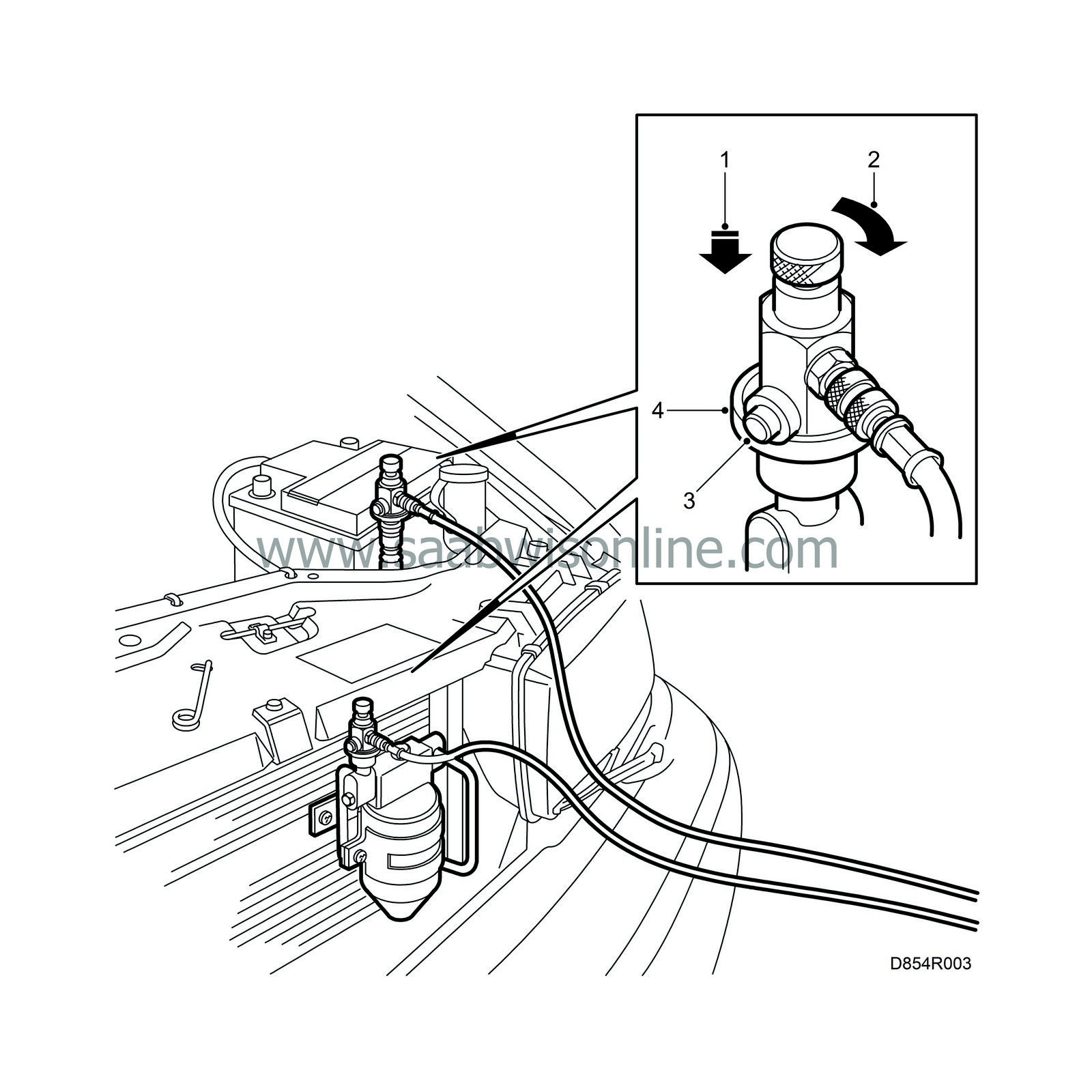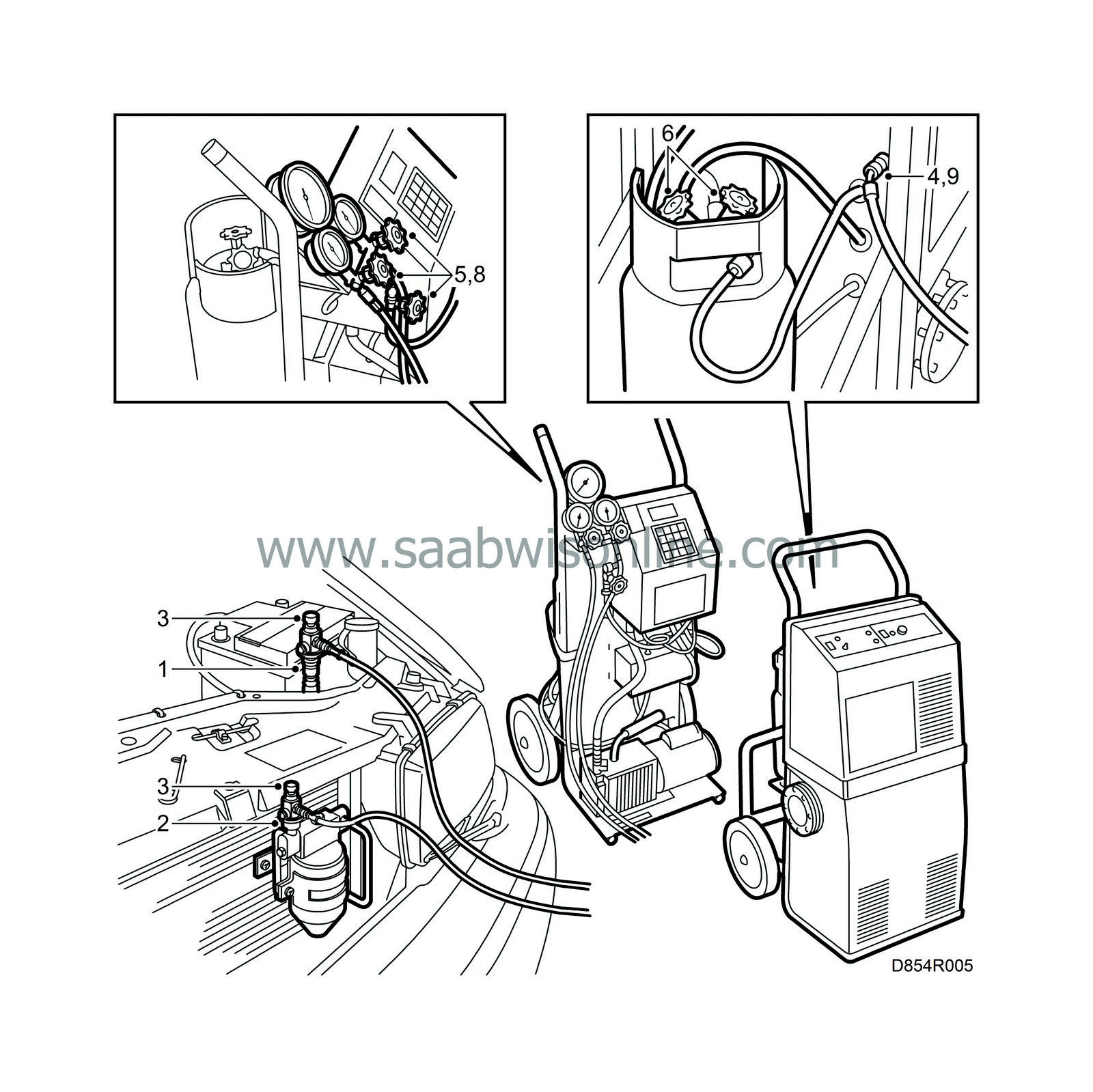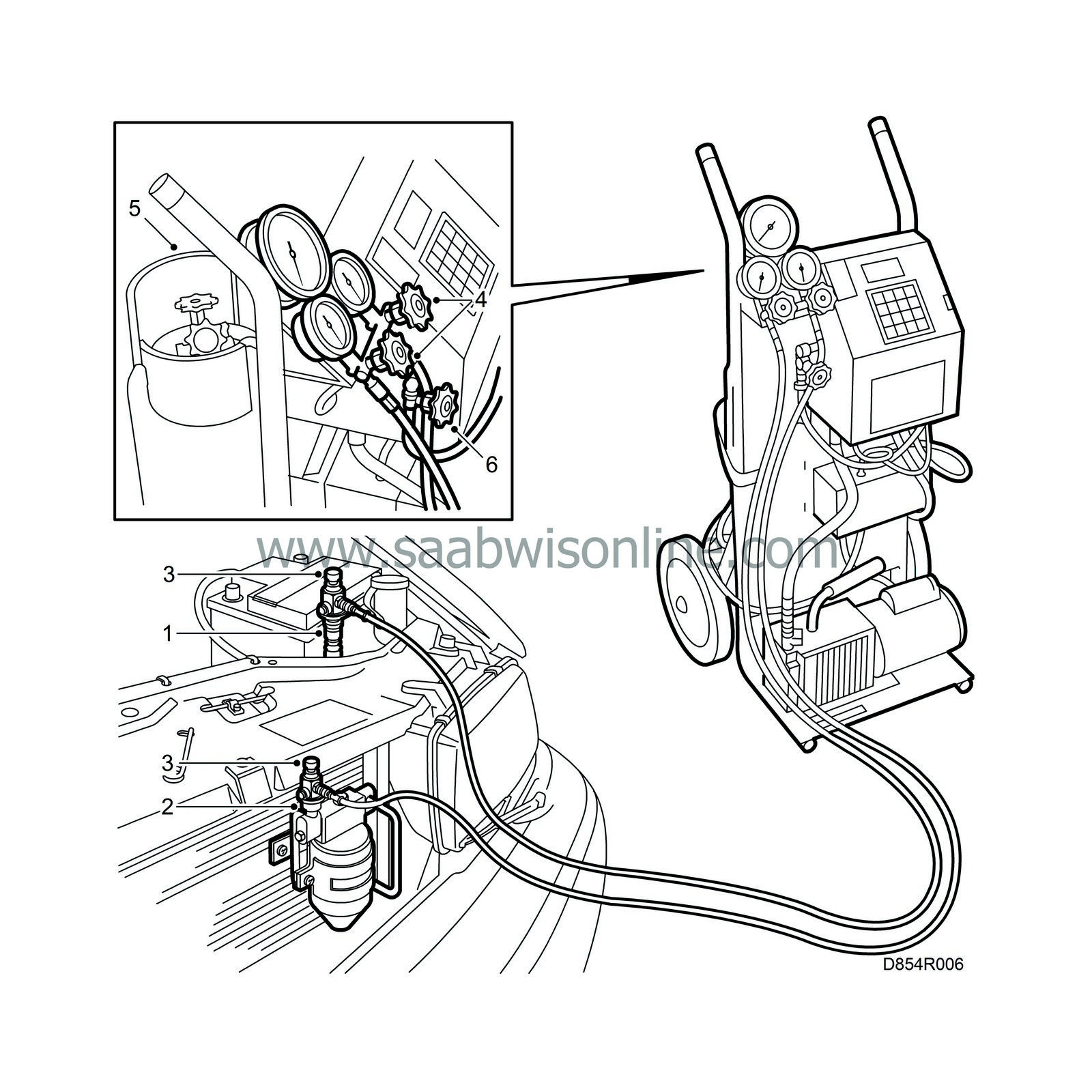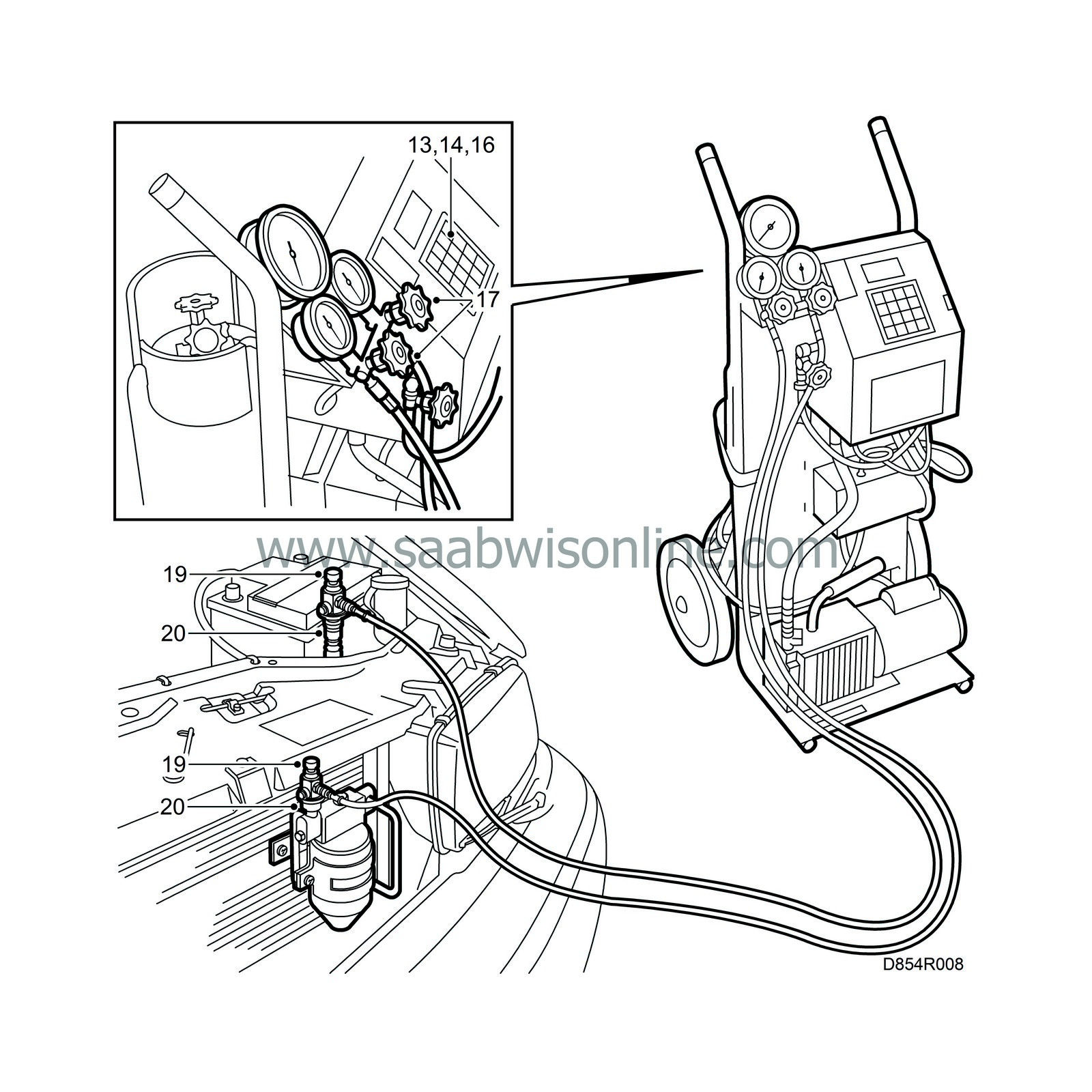Filling and draining refrigerant with Robinair Smart Cart 10324 Robinair 17234
|
|
Filling and draining refrigerant with Robinair Smart Cart 10324 Robinair 17234
|
 Warning
Warning
|
|
Read the following safety rules before beginning work on the A/C system:
|
|
•
|
Use protective goggles and tight-fitting gloves since there is a risk of corrosive injuries and frostbite.
|
|
•
|
If there is skin contact with the refrigerant, rinse the affected area with cold water and treat the injury as you would a burn injury.
|
|
•
|
If refrigerant should get into the eyes, rinse with plenty of running water for at least 10 minutes.
|
|
•
|
There must be no uncontrolled release of refrigerant into the atmosphere. If refrigerant should escape in the building, open and air out before continuing work.
|
|
•
|
Gases formed when the refrigerant is heated are harmful to personal health and can have a serious detrimental effect on the lungs.
|
|
•
|
Smoking and open flames are not allowed when handling refrigerant.
|
|
•
|
Refrigerant containers must not be exposed to heat as the pressure will increase, resulting in an explosion hazard.
|
|
|
|
|
|
The following text describes the use of the special equipment designed for draining and filling refrigerant R134a.
For information regarding the equipment itself, refer to the manufacturer's manuals.
Remember to drain the compressor oil from draining stations at regular intervals (every fourth draining is adequate).
|
Important
|
|
Draining and filling stations for refrigerant R134a must not for any reason be used for refrigerant R12, or vice versa.
|
|
|
Even small amounts of the wrong refrigerant or wrong compressor oil cause chemical reactions which will eventually damage the equipment and also the car's A/C system.

Special snap-on couplings are used to connect the draining and filling stations hoses to the A/C system service connections. The snap-on couplings are of the Schrader valve type and connection is accomplished in two steps:
|
1.
|
Press the snap-on coupling on the service connection.
|
|
2.
|
Turn in the knob clockwise so that the valve is opened and the refrigerant can pass through the connection.
|
When the snap-on couplings are disconnected, first turn the knob (2) counter-clockwise to close the valve. Then remove the snap-on coupling by pressing the spring-loaded catch (3) so that the locking sleeve (4) can be pulled up.
When the catch is pressed in, a hissing sound will be heard as the catch also serves to evacuate any refrigerant trapped in the snap-on coupling. The connections on the low-pressure and high-pressure side are of differing size to eliminate the risk for any mix-ups.
|
Checking pressure with Robinair 10324 Smart Cart
|

|
1.
|
Check to make sure that the valves on both the blue low-pressure and the red high-pressure hoses on the pressure gauge unit are closed.
|
|
2.
|
Connect the blue low-pressure hose with a snap-on coupling to the A/C system low-pressure side.
|
|
3.
|
Connect the red high-pressure hose with a snap-on coupling to the A/C system high-pressure side.
|
|
4.
|
Open the valves on both snap-on couplings by turning in the knobs.
|
|
5.
|
Start the engine.
At an engine speed of 1500 - 2000 rpm and an ambient temperature of 20°C, it should be possible to note the following on the pressure gauges when the compressor is operating:
Low-pressure side: 1.5-2.5 bar
|
|
Purging with the Robinair 10324 Smart Cart and Robinair 17234 purging station
|

|
1.
|
Connect the blue low-pressure hose with a snap-on coupling to the A/C system low-pressure side.
|
|
2.
|
Connect the red high-pressure hose with a snap-on coupling to the A/C system high-pressure side.
|
|
3.
|
Open the valves on both snap-on couplings by turning in the knobs.
|
|
4.
|
Connect the yellow hose from the pressure gauge stand middle outlet to the draining station.
|
|
5.
|
Open the valves for the blue low-pressure hose, the red high-pressure hose and the yellow hose on the pressure gauge unit middle outlet.
|
|
6.
|
On the draining station container, open the blue valve ("Liquid") for liquid refrigerant and the red valve ("Gas") for gaseous refrigerant.
|
|
7.
|
Start the draining station. The draining station will stop automatically when draining is completed.
|
|
8.
|
Close the valves for the blue low-pressure hose, the red high-pressure hose and the yellow hose on the pressure gauge stand middle outlet.
|
|
9.
|
Disconnect the yellow hose from the draining station. The draining is now completed and service of the A/C system can start.
|
|
Vacuum pumping and filling of refrigerant
|

Make sure the amount of compressor oil in the A/C system is correct before vacuum pumping and filling. See
Filling and adjusting compressor oil
.
|
Important
|
|
Vacuum pumping should be performed simultaneously on the low-pressure and high-pressure sides. A non-return valve in the low-pressure inlet on the compressor makes it impossible to vacuum pump on one side only.
|
|
|
|
1.
|
Connect the blue low-pressure hose with a snap-on coupling to the A/C system low-pressure side.
|
|
2.
|
Connect the red high-pressure hose with a snap-on coupling to the A/C system high-pressure side.
|
|
3.
|
Open the valves on both snap-on couplings by turning in the knobs.
|
|
4.
|
Open the valves for the blue low-pressure hose and the red high-pressure hose on the pressure gauge stand.
|
|
5.
|
Open the blue valve ("Liquid") for liquid form refrigerant on the Smart Cart container.
|
|
6.
|
Check to make sure that the valve for the yellow hose on the pressure gauge stand middle outlet is closed.
|
|
7.
|
Programme vacuum pumping for 30 minutes by pressing "30" on the control panel in the position "Vacuum minutes". Confirm the selection by pressing "ENTER".

|
|
9.
|
Press in "0.73" to indicate how many kilos of refrigerant that is to be filled. Confirm the selection by pressing "ENTER".
|
|
11.
|
Press "START" to begin vacuum pumping.
|
|
12.
|
Slightly move the A/C hoses. Check to make sure that there are no leaks in the system.
The pressure must not increase more than 10 mbar for 5 minutes.
|
|
13.
|
Press "START" to begin filling refrigerant.

 Warning
Warning
|
|
When a refrigerant flask is used, fill only from the A/C system low-pressure side. The flask may explode when the car is started if it is connected to the high-pressure side!
|
|
|
|
|
|
|
|
14.
|
Stop the filling by pressing "HOLD" when approximately 200 grammes of refrigerant has been filled.
|
|
15.
|
Slightly move the A/C hoses and check that the there are no leaks in the system using a leak detector intended for use with R134a.
|
|
16.
|
Continue filling by pressing "START".
When filling is completed, "CPL" will be shown on the control panel display.
|
|
17.
|
Close the valves for the blue low-pressure hose and the red high-pressure hose on the pressure gauge stand.
|
|
18.
|
Start the car and wait until the compressor begins to operate. Rev up the engine. The pressure on the low-pressure side must be in the range 1.5 and 3.0 bar.
|
|
19.
|
Close the snap-on coupling valves on the A/C system service connections by turning out the knobs.
|
|
20.
|
Disconnect the snap-on couplings and refit the protective caps over the service valves.
|






 Warning
Warning


